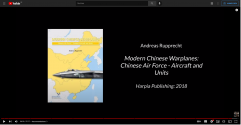You are using an out of date browser. It may not display this or other websites correctly.
You should upgrade or use an alternative browser.
You should upgrade or use an alternative browser.
China Flanker Thread II
- Thread starter sumdud
- Start date
- Status
- Not open for further replies.
J-15D.The right one too?
J-15D.
Really? The pylons/pods look slimmer than in comparison to the left one.
Equation
Lieutenant General
Here's another good video that you can find that talks about the Chinese flanker. Skip to 11:17 on the video if ya don't want to watch the other parts of the video. Mr. Justin Bronk gives a good description how China has came to turn their Russian design flanker into a better one than the Russian.
Wow, an unbiased review of PLAAF. Definitely one of the better channels out there.Here's another good video that you can find that talks about the Chinese flanker. Skip to 11:17 on the video if ya don't want to watch the other parts of the video. Mr. Justin Bronk gives a good description how China has came to turn their Russian design flanker into a better one than the Russian.
Here's another good video that you can find that talks about the Chinese flanker. Skip to 11:17 on the video if ya don't want to watch the other parts of the video. Mr. Justin Bronk gives a good description how China has came to turn their Russian design flanker into a better one than the Russian.
This video has been posted in other threads before, and overall the video is not very informative for most people on the forum that have been here for a while.
More than a few mistakes and frankly obsolete takes.
Just because it's packaged in an easy to consume video format doesn't really make it good.
Here's another good video that you can find that talks about the Chinese flanker. Skip to 11:17 on the video if ya don't want to watch the other parts of the video. Mr. Justin Bronk gives a good description how China has came to turn their Russian design flanker into a better one than the Russian.
It's a very good interview. Justin has given a very fair and comprehensive overview of J-16 and J-20, quite rare among Western military analysts.
If I can nitpick, I think Justin's view of Chinese military aircraft engines are somewhat behind the curve. WS-10B on J-16 is very likely more powerful and better than the AL-31F on Su-30. And China's primary interest in Su-35 is definitely not about reverse engineering its engine. What most of these western analysts don't understand is that China's aircraft engine development program has settled in a state where they have made substantial strides across the board based on the coherent and comprehensive roadmap. The notion that China can just arbitrarily insert some random, disruptive and significant reverse-engineering program into their comprehensive and methodological development plan at this stage is absurd.
J-20 is absolutely the right stealth fighter aircraft for China, a point that I made before at SDF. Its payload, range and speed are just superior to F-22 or F-35, and is so much better suited to Chinese requirements and circumstance. The J-20 design made the right tradeoff and stealth is an important but one part of the goal. Plus, it has large room for upgrades, particularly when WS-15 becomes available. With WS-15 (and its rumored 18.5 tons thrust), they can improve the all-aspect stealth plus other upgrades such as electronics. I dare to say that J-20 could be the best all-around 5th-generation fighter aircraft in the world after the upgrades.
Justin's comments on PLAAF training and doctrine are to-the-point and important. They're making a lot of changes, but the tradition and inertia can be a hindrance. That and PLAAF's operating environment are also limiting factor. But they're speeding up the transition by operating more and far into the Western Pacific, as well as around Taiwan.
Do any of those “...more than a few mistakes and frankly obsolete takes...” occur after 35:55? LOL!!!This video has been posted in other threads before, and overall the video is not very informative for most people on the forum that have been here for a while.
More than a few mistakes and frankly obsolete takes.
Just because it's packaged in an easy to consume video format doesn't really make it good.
I’m usually not keyboard illiterate, but can someone suggest why I can’t post emojis, please?
Who said the stealth design of the J-20 is fundamentally compromised and needs/could be improved?The J-20 design made the right tradeoff and stealth is an important but one part of the goal... they can improve the all-aspect stealth plus other upgrades such as electronics.
- Status
- Not open for further replies.

